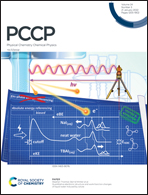Early thermal decay of energetic hydrogen- and nitro-free furoxan compounds: the case of DNTF and BTF†
Abstract
Exploration of the initial reactions of H-free and nitro-free energetic materials could enrich our understanding of the thermal decomposition mechanism of various energetic materials (EMs). In this work, two furoxan compounds, 3,4-dinitrofurazanfuroxan (DNTF) and benzotrifuroxan (BTF), were investigated to shed light on the decay mechanism of furoxan compounds based on the combination of self-consistent charge density functional tight binding and molecular dynamics simulations. The results show that DNTF and BTF decay via a unimolecular mechanism, and the transformation of the furoxan ring into a nitro group is suggested as a novel initial channel. Five initial steps of DNTF thermal decomposition are observed, including NO2 loss and the N(O)–O bond cleavage of the central and peripheral rings. The bond cleavage of peripheral rings dominates the decay at low temperatures, while the central ring opening and C–NO2 dissociation govern the high temperature decay. Besides, NO2, CO and NO fragments are mainly yielded at high temperatures, while CO3N2 is dominant at low temperatures. The three-stage characteristic of the exothermic BTF decay is described under programmed heating conditions for the first time. Four initial steps of BTF thermal decomposition were identified, including furoxan ring opening reactions and the breakage of the 6-membered ring C–C bond. The cleavage of the N(O)–O bond is dominant in the initial step of BTF decomposition under different heating conditions, and the frequency increases with increasing temperature. In addition, the amounts of CON, ON and CO are higher at high temperatures, while C2O2N2 shows an opposite trend. The findings of this work provide deep insights into the complicated sensitivity mechanism of EMs.



 Please wait while we load your content...
Please wait while we load your content...